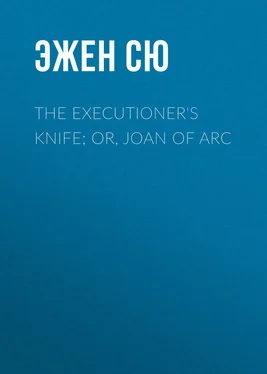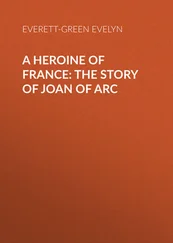Эжен Сю - The Executioner's Knife; Or, Joan of Arc
Здесь есть возможность читать онлайн «Эжен Сю - The Executioner's Knife; Or, Joan of Arc» — ознакомительный отрывок электронной книги совершенно бесплатно, а после прочтения отрывка купить полную версию. В некоторых случаях можно слушать аудио, скачать через торрент в формате fb2 и присутствует краткое содержание. Издательство: Иностранный паблик, Жанр: literature_19, foreign_antique, foreign_prose, на английском языке. Описание произведения, (предисловие) а так же отзывы посетителей доступны на портале библиотеки ЛибКат.
- Название:The Executioner's Knife; Or, Joan of Arc
- Автор:
- Издательство:Иностранный паблик
- Жанр:
- Год:неизвестен
- ISBN:нет данных
- Рейтинг книги:5 / 5. Голосов: 1
-
Избранное:Добавить в избранное
- Отзывы:
-
Ваша оценка:
- 100
- 1
- 2
- 3
- 4
- 5
The Executioner's Knife; Or, Joan of Arc: краткое содержание, описание и аннотация
Предлагаем к чтению аннотацию, описание, краткое содержание или предисловие (зависит от того, что написал сам автор книги «The Executioner's Knife; Or, Joan of Arc»). Если вы не нашли необходимую информацию о книге — напишите в комментариях, мы постараемся отыскать её.
The Executioner's Knife; Or, Joan of Arc — читать онлайн ознакомительный отрывок
Ниже представлен текст книги, разбитый по страницам. Система сохранения места последней прочитанной страницы, позволяет с удобством читать онлайн бесплатно книгу «The Executioner's Knife; Or, Joan of Arc», без необходимости каждый раз заново искать на чём Вы остановились. Поставьте закладку, и сможете в любой момент перейти на страницу, на которой закончили чтение.
Интервал:
Закладка:
Eugène Sue
The Executioner's Knife; Or, Joan of Arc
Whether one will be satisfied with nothing but a scientific diagnosis in psychology, or a less ponderous and infinitely more lyric presentation of certain mental phenomena will do for him; whether the student of history insist on strict chronology, or whether he prize at its true value the meat and coloring of history; whether a reader prefer in matters canonical the rigid presentation of dogma, or whether the tragic fruits of theocracy offer a more attractive starting point for his contemplation; – whichever the case might be, The Executioner's Knife; or, Joan of Arc will gratify his intellectual cravings on all the three heads.
This, the fifteenth story of the series of Eugene Sue's matchless historic novels entitled The Mysteries of the People; or, History of a Proletarian Family Across the Ages , presents the picture of the Fifteenth Century – a historic elevation climbed up to from the hills of the era sketched in the preceding story, The Iron Trevet; or Jocelyn the Champion , and from which, in turn, the outlines become vaguely visible of the critically historic era that forms the subject of the next story, The Pocket Bible; or, Christian the Printer .
As in all the stories of this stupendous series bestowed by the genius of Sue upon posterity, the leading characters are historic, the leading events are historic, and the coloring is true to history. How true to the facts are the historic revelations made by the author in this series, and how historically true are the conclusions he draws, as they rise in relief on the canvas of these novels, appears with peculiar conspicuousness in The Executioner's Knife; or, Joan of Arc , above all in this century, when the science of history has remodeled its theory, and, instead of, as in former days, basing man's acts upon impulse, has learned to plant impulse upon material facts.
In the pages of this story the central figure is the charming one generally known to history as the Maid of Orleans. If ever there was in the annals of man a figure that superstitious mysticism combined with grovelling interests to annihilate, it was the figure of the pure-minded, self-sacrificing, intrepid shepherdess of Domremy. Even the genius of a Voltaire succumbed. In righteous revolt against man-degrading superstition, his satire "La Pucelle" in fact contributed, by the slur it placed upon Joan, to vindicate the very lay and prelatical interests he fought, and whose predecessors dragged her name through the ditch and had consigned her body to the flames. Harried by the political interests whom her integrity of purpose menaced and actually thwarted; insulted and put to death by the allies of these, ambushed behind religion; the successors of both elements perpetuating the wrong with false history; and even the enlightened contributing their sneers out of just repugnance for supernaturalism; – all this notwithstanding, the figure of Joan triumphed. Even the head of the prelatic political machine, which had presumed to speak in the name of the Deity with Anathema over Joan's head, has felt constrained to fall in line with the awakened popular knowledge. The Papal beatification of Joan of Arc in this century is a public retraction and apology to the heroine born from the lowly.
Of the many works of art – poetic, dramatic, pictorial – that have contributed to this conspicuous "reversal of judgment" Sue's The Executioner's Knife; or, Joan of Arc has been the most powerful. The pathetic story cleanses Joan of the miraculous, uncovers the grovelling influences she had to contend against, exposes the sordid ambitions she had to overcome and that finally slaked their vengeance in her blood. The master's hand weaves together and draws, in the garb of fiction, a picture that is monumental – at once as a work of science, of history and of art.
DANIEL DE LEON.Milford, Conn., October, 1909.
PART I
DOMREMY
CHAPTER I
JEANNETTE
Domremy is a frontier village of Lorraine that cosily nestles on the slope of a fertile valley whose pasture grounds are watered by the Meuse. An oak forest, that still preserves some mementoes of druid tradition, reaches out almost to the village church. This church is the handsomest of all in the valley, which begins at Vaucouleurs and ends at Domremy. St. Catherine and St. Marguerite, superbly painted and gilded, ornament the sanctuary. St. Michael, the Archangel, with his sword in one hand and the scales in the other, glistens from the depths of a dark recess in the chapel. Happy is the valley that begins at Vaucouleurs and ends at Domremy! A royal seigniory, lost on the confines of Gaul, it has not yet suffered from the disasters of war that for more than a half century have been desolating the center of the country. Its inhabitants, profiting by the civil broils of their sovereign and his distance from them, being separated from his main domains by Champagne, which had fallen into the power of the English, had emancipated themselves from serfdom.
James Darc, a member of a family that had long been serfs of the Abbey of St. Remy, and subsequently of the Sire of Joinville before the fief of Vaucouleurs was consolidated with the royal domain, an honest laborer, stern head of his household and rather rude of manners, lived by the cultivation of the fields. His wife was called Isabelle Romée; his eldest son, Peter; the second, John; and his daughter, born on "the day of Kings" in 1412, was named Jeannette. At the time when this narrative commences, Jeannette was a little over thirteen years of age. She was of pleasant appearance, a sweet and pious child and endowed with precocious intelligence. Her disposition was serious for her age. This notwithstanding, she joined in the games of other girls, her friends, and never gloried in her own superior agility when, as usually happened, she won in the races. She could neither read nor write. Active and industrious, she helped her mother in the household, led the sheep to pasture and was skilful with the needle and at the distaff. Often pensive, when alone in secluded spots of the woods she watched over her flock, she found an inexpressible delight in listening to the distant sound of the church bells, to the point that at times she made little presents of fruits or skeins of wool to the parish clerk of Domremy, joining to the gifts the gentle request that he prolong a little the chimes of the vespers or of the Angelus. 1 1 Trial and Condemnation, and Proceedings of the Rehabilitation of Joan of Arc, known as The Maid , by Jules Quicherat, after the manuscripts in the Royal Library; vol. I, p. 39.
Jeannette also took delight in leading her sheep in the ancient forest of oaks, known as the "Bois Chesnu", 2 2 The same.
towards a limpid spring shaded by a beech tree that was between two and three hundred years old and which was known in the region as the "Fairies' Tree". The legend had it that the priests of the old gods of Gaul sometimes appeared, dressed in their long white robes, under the dark vaults of the oaks of this forest, and that often little fairies approached the fountain by moonlight to see their reflection in its waters.
Jeannette did not fear the fairies, knowing that a single sign of the cross would put any malignant sprite to flight. She entertained a special spirit of devotion for St. Marguerite and St. Catherine, the two beautiful saints of the parish. When, on feast days, she accompanied her venerated parents to divine service, she was never tired of contemplating and admiring the good saints, who were at once smiling and majestic under their golden crowns. Likewise did St. Michael attract her attention. But the severity of the archangel's face and his flaming sword somewhat intimidated the young shepherdess, while, on the contrary, her dear saints inspired her with ineffable confidence.
Читать дальшеИнтервал:
Закладка:
Похожие книги на «The Executioner's Knife; Or, Joan of Arc»
Представляем Вашему вниманию похожие книги на «The Executioner's Knife; Or, Joan of Arc» списком для выбора. Мы отобрали схожую по названию и смыслу литературу в надежде предоставить читателям больше вариантов отыскать новые, интересные, ещё непрочитанные произведения.
Обсуждение, отзывы о книге «The Executioner's Knife; Or, Joan of Arc» и просто собственные мнения читателей. Оставьте ваши комментарии, напишите, что Вы думаете о произведении, его смысле или главных героях. Укажите что конкретно понравилось, а что нет, и почему Вы так считаете.












